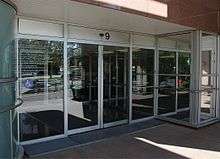Safety Investigation Authority
The Safety Investigation Authority of Finland (SIAF[1] or SIA,[2] Finnish: Onnettomuustutkintakeskus, lit. Accident Investigation Center, shortened to OTKES; Swedish: Olycksutredningscentralen) is the accident investigation authority of Finland. It investigates all major accidents, and all aviation, maritime, and rail accidents and incidents.[3] SIAF is located within the Ministry of Justice,[3] and is headquartered in Helsinki, Finland.[4]


Head office of the Safety Investigation Authority of Finland
The SIAF was previously known in English as the Accident Investigation Board of Finland.[5]
Organization
The SIAF consists of five investigation branches: aviation, maritime, rail, other accidents, and exceptional events. The SIA has appointed a chief investigator to each.[6]
| Investigation branch | Description | Chief investigator |
|---|---|---|
| Aviation | The investigation of incidents and accidents regarding aviation in Finland.[7] | Ismo Aaltonen |
| Maritime | The investigation of accidents and dangerous situations that take place on Finnish territorial waters or in which a Finland-based vessel is involved.[8] |
Risto Haimila |
| Rail | The investigation of especially hazardous accidents that happen either in rail, metro, or tram traffic, such as level crossing accidents, rolling stock fires, and train collisions.[9] |
Esko Värttiö |
| Other accidents | The Other accidents-branch investigates serious accidents that pose a risk to life or that cause significant economic or environmental harm.[10] | Kai Valonen |
| Exceptional events | Exceptional events are events of a non-accidental nature, in which a severe risk to life and society is posed. The SIAF has investigated four of such events during its history: the Jokela school shooting (2007), Kauhajoki school shooting (2008), death of 8-year-old Eerika (2012), and Turku stabbing (2017).[11] |

This two tachographs were retrieved by the Safety Investigation Authority from the Konginkangas bus disaster in 2004
gollark: oh bees oh bees my JS project from 8 months ago won't compile with 12897187461872 errors.
gollark: What language *is* this?
gollark: --random 3d6
gollark: ```python>>> for x in cast(id(False), POINTER(c_byte * sys.getsizeof(False))).contents: print(x, end=" ")-86 0 0 0 0 0 0 0 -32 -63 44 -117 69 127 0 0 0 0 0 0 0 0 0 0```Fascinating.
gollark: I assume it's already been used there, or at least a similar thing.
References
- "M2013-02 ms FINNARROW contact with quay in Holyhead 16 February 2013." Onnettomuustutkintakeskus. 20 February 2013. Retrieved on 12 May 2013.
- "SIA - Onnettomuustutkintakeskus". www.turvallisuustutkinta.fi. Retrieved 2017-11-20.
- "Role and function". Accident Investigation Board Finland. Retrieved 28 October 2010.
- "Accident Investigation Board Finland – In English". Accident Investigation Board Finland. Retrieved 28 October 2010.
- "Annual Report 2009." Accident Investigation Board of Finland. Retrieved on 11 May 2013.
- "Organisation - Onnettomuustutkintakeskus". www.turvallisuustutkinta.fi. Retrieved 2017-11-20.
- "Aviation - Onnettomuustutkintakeskus". www.turvallisuustutkinta.fi. Retrieved 2017-11-20.
- "Marine - Onnettomuustutkintakeskus". www.turvallisuustutkinta.fi. Retrieved 2017-11-20.
- "Rail - Onnettomuustutkintakeskus". www.turvallisuustutkinta.fi. Retrieved 2017-11-20.
- "Muut onnettomuudet - Onnettomuustutkintakeskus". www.turvallisuustutkinta.fi. Retrieved 2017-11-20.
- "Exceptional events - Onnettomuustutkintakeskus". www.turvallisuustutkinta.fi. Retrieved 2017-11-20.
External links
- Safety Investigation Authority
- Safety Investigation Authority (in Finnish)
- Safety Investigation Authority (in Swedish)
- Accident Investigation Act (373/1985) (in Finnish) (Archive)
This article is issued from Wikipedia. The text is licensed under Creative Commons - Attribution - Sharealike. Additional terms may apply for the media files.